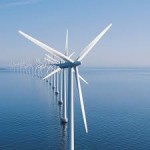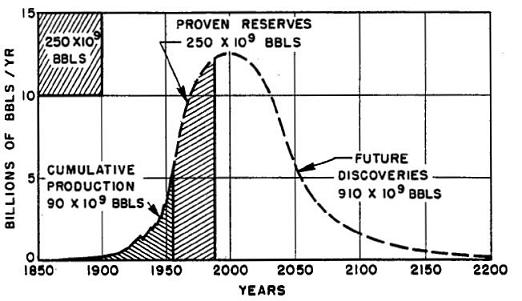This post was published by OpEd News,
Peak Oil , re-posted Hubberts Peak, The Economy, and War for Oil
I came across an historic and seminal document on a website called Energy & Capital https://www.energyandcapital.com/articles/past-peak-oil/3109, that had a link to Marion King Hubbert’s 1956 speech about Peak Oil. Hubbert asserted that global oil production would follow a bell-shaped curve with a peak followed by an irrevocable decline.
Marion King Hubbert was an unlikely prophet. When he wrote this memo and presented it  he was working for Shell oil as a geologist. In the paper that he presented to the American Petroleum Institute “Hubbert correctly predicted that production of oil would peak in the continental US around 1965-1970. Hubbert further predicted a worldwide peak at about 50 years from publication of his memo. https://en.wikipedia.org/wiki/Hubbert_peak_theory. Peak Oil is neither a theory, nor does it mean the world is running out of oil. The question however is whether or not we’ll be able to economically produce that oil,and what the more expensive less easily recovered oil will do to our economy already teetering on the edge of an energy, environmental, economic, and equity crisis?
he was working for Shell oil as a geologist. In the paper that he presented to the American Petroleum Institute “Hubbert correctly predicted that production of oil would peak in the continental US around 1965-1970. Hubbert further predicted a worldwide peak at about 50 years from publication of his memo. https://en.wikipedia.org/wiki/Hubbert_peak_theory. Peak Oil is neither a theory, nor does it mean the world is running out of oil. The question however is whether or not we’ll be able to economically produce that oil,and what the more expensive less easily recovered oil will do to our economy already teetering on the edge of an energy, environmental, economic, and equity crisis?
That America’s oil would peak by 1970 was dismissed by everyone in the petroleum industry. But when U.S. oil production did peak in November of 1970 Hubbert’s work began to be taken seriously by scientists in the petroleum industry, government, and academia. This information did not make a media splash and the public was largely kept in the dark because the oil companies and the US government were reluctant to alarm the beneficiaries of the cheap oil that powered America and the developed world’s consumer based, fossil fuel addicted economy.
Hubbert predicted that world oil supply would peak around 2000 (many observers now  agree that it actually peaked in 2004). But even today, few people in government or the corporate media have been warning the public about the implications for the economy.
agree that it actually peaked in 2004). But even today, few people in government or the corporate media have been warning the public about the implications for the economy.
This dearth of coverage is partly because the oil producing countries and the oil companies do not want to publish or confirm data on the amount of oil reserves because if the world has hit “Peak Oil” and is sliding down slope to scarcity, such a message could spark a panic in the markets or a rush to investment in alternative energy and fuels that would be damaging to the bottom line of fossil fuel industries. It would also shine a bright light on America’s misguided strategy for keeping the oil flowing, and prices low.
The US government has done everything it can to keep the price of oil artificially low through subsidies, tax breaks, and incentives. Some of the recipients of this government largesse have spent $ millions in lobbying to support their congressional cronies. The biggest contributors, Shell, Exxon, and Conoco Phillips, have spent over $105 million on lobbying Congress since 2011. Oil PACs have donated over $2.16 million to mostly Republican candidates. Koch Industries spent $16.2 million on lobbying and more than $1.3 million from its PAC.
To keep prices stable, oil producing countries look like they are competing to see which can “produce” the most oil. In reality they are vying to see which will reach the bottom of the barrel first. In this race to the bottom, these producers including the US are creating, environmental havoc.
The problem is exacerbated by the hype that arctic oil reserves, or Canadian tar sands, more off shore deep water drilling, or “fracking” will preserve the status quo or even reverse the slide to scarcity. The problem with these solutions is the “energy return on investment” (EROL). EROL is important because dwindling fossil fuels are beginning to use more energy to extract then they produce.
Although renewable technologies already have a better EROL than fossil fuels, very few countries (except perhaps Germany) are committed to the kind of program that would soften the “crash” that is likely to happen when energy produced by fossil fuels and nuclear become extremely expensive and scarce. EROI is important because it’s falling fast in the fossil fuel space, as dwindling supplies take more energy to extract. The  problem is, we built industrial society on fossil fuels, while a sustainable society must be built on renewable energy.
problem is, we built industrial society on fossil fuels, while a sustainable society must be built on renewable energy.
Chris Martenson, on his blog, and in his book The Crash Course has a very scary chart illustrating how many thousands of nuclear power plants, hundreds of thousands of acres of solar arrays, hundreds of thousands of wind turbines, or millions of acres of soy beans or corn that will be needed to replace the liquid fuel equivalent needed to maintain a consumptive western society at 2009 levels. In the case of bio fuels, the world would need to plant more acreage in soy and corn that is in total agricultural use in world today. The notion that “they will come up with something to replace oil” is thoughtless and irresponsible. Even in countries with a robust alternatives program there does not appear to be enough time, money, or “bridge fuels” to make the transition painlessly. Continue reading
today. The notion that “they will come up with something to replace oil” is thoughtless and irresponsible. Even in countries with a robust alternatives program there does not appear to be enough time, money, or “bridge fuels” to make the transition painlessly. Continue reading

